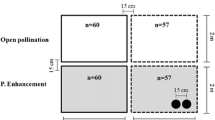Summary
To examine the effects of pollen and resource availability on floral display and fruit set in Chilopsis linearis three different types of experimental manipulations were performed. Pollen availability to individual inflorescences was altered by combinations of hand-pollinations and/or pollinator exclusions. Number of flowers produced per inflorescence was determinate; it was not affected by pollination, although flowers of the unpollinated treatment lasted longer. Fruit set was increased over natural levels by an average of 540% by hand-pollinating individual inflorescences. There was also a negative correlation between inflorescence size and percent fruit set in all treatments tested. Attempts to vary resources available to individual inflorescences and entire trees showed no significant effect on fruit set. These results show that, at the level of individual inflorescences, fruit and seed production in Chilopsis linearis are pollen limited and not resource limited. The problem of testing for resource limitation of female reproductive success in iteroparous plants and the effect of inflorescence size on female components of fitness are also discussed.
Similar content being viewed by others
References
Bateman AJ (1948) Intra-sexual selection in Drosophila. Heredity 2:349–368
Brown JH, Kodric-Brown A, Whitham TG, Bond HW (1981) Competition between hummingbirds and insects for the nectar of two species of shrubs. Southwestern Naturalist 26:133–145
Charnov EL (1979) Simultaneous hermaphroditism and sexual selection. Proc Nat Acad Sci U.S. 76:2480–2484
Gentry AH (1974) Coevolutionary patterns in Central American Bignoniaceae. Ann Miss Bot Gard 61:728–759
Janzen DH (1977) A note on optimal mate selection by plants. American Naturalist 111:365–371
Kodric-Brown A, Brown JH (1979) Competition between distantly related taxa in the coevolution of plants and pollinators. American Zoologist 19:1115–1127
Pielou EC (1969) An introduction to mathematical ecology. New York: Wiley-Interscience, John Wiley and Sons, Inc
Schemske DW (1980) Evolution of floral display in the orchid Brassavola nodosa. Evolution 34:489–493
Stephenson AG (1979) An evolutionary examination of the floral display of Catalpa speciosa (Bignoniaceae). Evolution 33:1200–1209
Stephenson AG (1980) Fruit set, herbivory, fruit reduction, and the fruiting strategy of Catalpa speciosa (Bignoniaceae). Ecology 61:57–64
Sutherland S (Manuscript) Resource-limited fruit set in paniculate agaves: a test of Bateman's principle
Udovich D, Aker C (in press) Fruit abortion and the regulation of fruit number in Yucca whipplei Oecologia
Waser NM (1978) Competition for hummingbird pollination and sequential flowering in two Colorado wildflowers. Ecology 59:934–944
Whitham TG Coevolution of foraging in Bombus and nectar dispensing in Chilopsis: A last dreg theory. Science 197:593–596
Willson MF (1979) Sexual selection in plants. American Naturalist 113:777–790
Zimmerman M (1980) Reproduction in Polemonium: competition for pollinators. Ecology 61:497–501
Author information
Authors and Affiliations
Rights and permissions
About this article
Cite this article
Petersen, C., Brown, J.H. & Kodric-Brown, A. An experimental study of floral display and fruit set in Chilopsis linearis (Bignoniaceae). Oecologia 55, 7–11 (1982). https://doi.org/10.1007/BF00386711
Received:
Issue Date:
DOI: https://doi.org/10.1007/BF00386711




